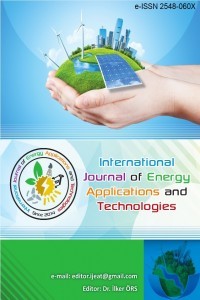Installation of solar power plant in Adıyaman region and analysis of solar energy potential
Renewable Energy, Solar energy, Green Energy, Solar Power Plant
Installation of solar power plant in Adıyaman region and analysis of solar energy potential
Green Energy, Renewable Energy, Solar energy, Solar Power Plant,
___
- Karapekmez, A., & Dincer, I. (2020). Comparative efficiency and environmental impact assessments of a solar-assisted combined cycle with various fuels. Applied Thermal Engineering, 164, 114409.
- Das, U. K., Tey, K. S., Seyedmahmoudian, M., Mekhilef, S., Idris, M. Y. I., Van Deventer, W., ... & Stojcevski, A. (2018). Forecasting of photovoltaic power generation and model optimization: A review. Renewable and Sustainable Energy Reviews, 81, 912-928.
- Üstün, İ., Üneş, F., Mert, İ., & Karakuş, C. (2022). A comparative study of estimating solar radiation using machine learning approaches: DL, SMGRT, and ANFIS. Energy Sources, Part A: Recovery, Utilization, and Environmental Effects, 44(4), 10322-10345.
- Ustun, I., Karakus, C., & Yagli, H. (2020). Empirical models for estimating the daily and monthly global solar radiation for Mediterranean and Central Anatolia region of Turkey. International Journal of Global Warming, 20(3), 249-275.
- Özyurt, G., & Karabalık, K. (2009). Enerji verimliliği, binaların enerji performansı ve Türkiye’deki durum.TMMOB, İnşaat Mühendisleri Odası, Türkiye Mühendislik Haberleri, 457(54), 32-34.
- Ferreira, A., Kunh, S. S., Fagnani, K. C., De Souza, T. A., Tonezer, C., Dos Santos, G. R., & Coimbra-Araújo, C. H. (2018). Economic overview of the use and production of photovoltaic solar energy in Brazil. Renewable and Sustainable Energy Reviews, 81, 181-191.
- Kong, L. G., Chen, X. L., Gong, J. H., Fan, D. J., Wang, B. L., & Li, S. (2022). Optimization of the hybrid solar power plants comprising photovoltaic and concentrating solar power using the butterfly algorithm. Energy Conversion and Management, 257, 115310.
- Şevik, S., & Aktaş, A. (2022). Performance enhancing and improvement studies in a 600 kW solar photovoltaic (PV) power plant; manual and natural cleaning, rainwater harvesting and the snow load removal on the PV arrays. Renewable Energy, 181, 490-503.
- Bansal, N., Pany, P., & Singh, G. (2021). Visual degradation and performance evaluation of utility scale solar photovoltaic power plant in hot and dry climate in western India. Case Studies in Thermal Engineering, 26, 101010.
- Ömeroğlu, G. (2018). Fotovoltaik-termal (PV/T) sistemin sayısal (CFD) ve deneysel analizi. Fırat University Journal of Engineering Science, 30(1), 161-167.
- Çağlar, A. (2018). Farklı derece-gün bölgelerindeki şehirler için optimum eğim açısının belirlenmesi. Süleyman Demirel Üniversitesi Fen Bilimleri Enstitüsü Dergisi, 22(2), 849-854.
- Alcan, Y., Demir, M., & Duman, S. (2018). Sinop ilinin güneş enerjisinden elektrik üretim potansiyelinin ülkemiz ve Almanya ile karşılaştırarak incelenmesi. El-Cezeri Journal of Science and Engineering, 5(1), 35-44.
- Kırcıoğlu, O., Ünlü, M., & Çamur, S. (2018). Performance evaluation of the perturb & observe and incremental conductance algorithms according to the EN 50530 dynamic efficiency test. Sakarya University Journal of Science, 22(1), 85-93.
- Meteoroloji Genel Müdürlüğü, (2022). The access site is given as follows; https://www.mgm.gov.tr/veridegerlendirme/il-ve-ilceler-istatistik.aspx?k=undefined&m=Adiyaman. (01 November 2022).
- Kallioğlu, M. A., Ercan, U., Avcı, A. S., Karakaya, H., & Durmuş, A. (2017). Adıyaman ilinde yatay düzleme gelen global güneş ışınım değerlerinin ampirik modeller ile geliştirilmesi. Science and Eng. J of Fırat Univ., 29(1), 151-159.
- Aslan, M., Ulum, T., & Türkmenler, H. (2021). Adıyaman ilinin yenilenebilir enerji potansiyelinin belirlenmesi üzerine bir değerlendirme. Fırat University Journal of Engineering, 33(1), 263-274.
- Taktak, F., & Ilı, M. (2018). Güneş enerji santrali (GES) geliştirme: Uşak örneği. Journal of Geomatics, 3(1), 1-21.
- Internet, URL:https://www.enerjiatlasi.com/elektrik-fiyatlari/, (14 October 2022).
- Lüle, F. (2018). Adıyaman ilinin enerji kaynakları potansiyeli. Journal of Agricultural Machinery Science, 14(1), 1-5.
- Yalılı, M. (2021). Lisanslı fotovoltaik güneş enerji santrali yatırımının finansal analizi: Van ili örneği. Bitlis Eren Üniversitesi Fen Bilimleri Dergisi, 10(3), 1055-1074.
- Yayın Aralığı: Yılda 2 Sayı
- Başlangıç: 2014
- Yayıncı: İlker ÖRS
Experimental investigation of spoiler application in an SUV type vehicle
Hasan ÇİFTÇİ, Cihan BAYINDIRLI, İlker ÖRS
Installation of solar power plant in Adıyaman region and analysis of solar energy potential
Veysel TURAN, Cuma KARAKUŞ, İsmail ÜSTÜN
Using solar energy in galvanic anode cathodic protection systems
Niyazi KARABACAK, Abdulhakim KARAKAYA
Investigation of the economic aspects of air source heat pump usage for Izmir province
